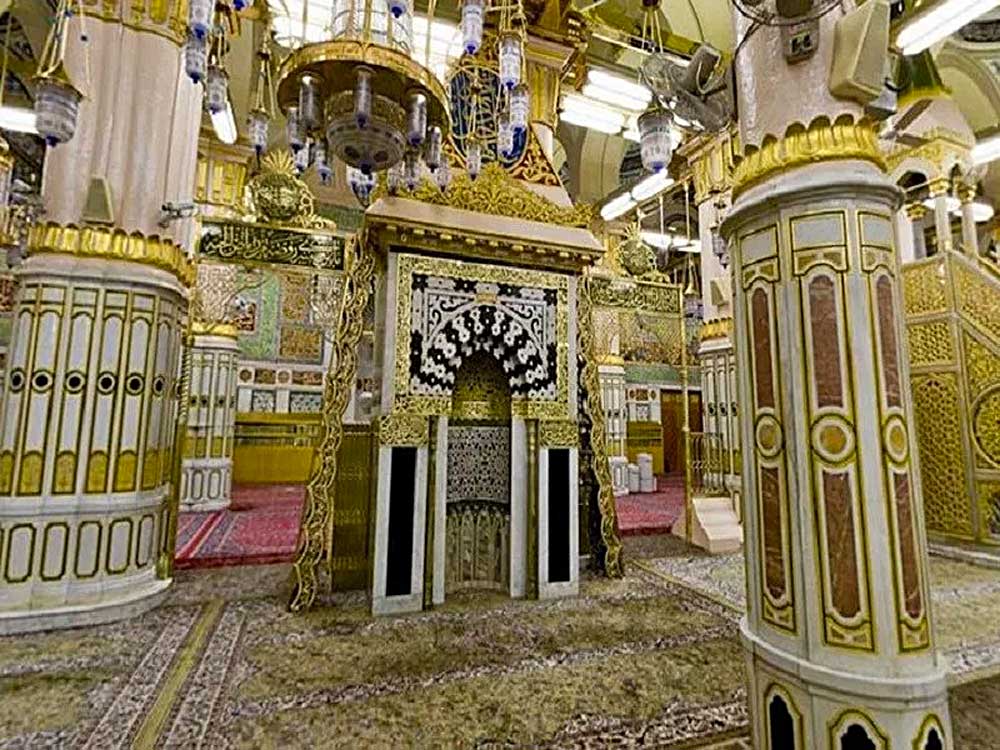Riadhul Jannah & Mehrab

The Riadhul Jannah area with the mimbar on the right and mehrab on the left
The area between the Sacred Chamber and the Pulpit (Mimbar) is known as the Riadhul Jannah i.e. Garden of Paradise. It is presently distinguished by a green carpet and is also referred to as Rawdah.
- Abu Hurairah (may Allah be pleased with him) narrated that the Prophet (peace and blessings of Allah be on him) said: “ Between my house and my pulpit lays a garden from the gardens of Paradise, and my pulpit is upon my fountain (Al-Kauthar).” [Bukhari]
- Scholars have interpreted the above narration as follows: The Garden is parallel to a garden above it in Paradise. Or it is in reality a garden of paradise, which will be returned to paradise in the hereafter. Or it is like the gardens of paradise, because the peace and tranquility which is experienced in it when engaged in the remembrance of Allah resembles that of paradise. [Akhbar Madina tur Rasool, Ibn Najjar]
- The original size Is approximately 22 meters in length and 15 meters in width, part of it is in the chamber of the Prophet (peace and blessings of Allah be on him).
Mehrab (Prayer niche):

Front view of the Mehrab
- The Prophet (peace and blessings of Allah be on him) prayed for about 16 months facing towards Al-Quds in Jerusalem on his arrival in Medina. If one was to walk away from the ‘ Aisha column’ , leaving it towards your back, the fifth column will be in line with the door marked as Bab-e-Jibraeel. This fifth column was the approximate praying spot of the Prophet (peace and blessings of Allah be on him) for the above period. It was near to the extreme north boundary of the original mosque.
- After the change in Qibla, the Prophet (peace and blessings of Allah be on him) offered salah near Aisha’ s column for a short period while facing towards the Ka’ bah. Later he started leading salat at the spot where the Mehrab Nabwi is nowadays. Note that there was no mehrab at this spot during the period of the Prophet (peace and blessings of Allah be on him) and the four Caliphs.
- In 91 AH, Umar bin Abdul Aziz made a praying niche in the form of a mehrab. Since then it is called Mehrab Nabwi. If you were to stand in the mehrab for offering salah, your place of sajda will be where Prophet’ s (peace and blessings of Allah be on him) feet used to be. The Prophet’ s (peace and blessings of Allah be on him) place of sajda is intentionally covered by the thick wall of the mehrab.
Mimbar (pulpit):

Close up view of the present Pulpit (Mimbar)
- The Prophet (peace and blessings of Allah be on him) used to lean against the trunk of a palm tree when he was tired or exhausted while delivering a sermon. The Ansar humbly suggested to him, “ If you approve, we can make a pulpit for you.” The Prophet (peace and blessings of Allah be on him) approved it and a pulpit was made. Prophet Muhammad (peace and blessings of Allah be on him) sat on this pulpit to make an address. When the Prophet (peace and blessings of Allah be on him) started using the new pulpit, the old tree yearned for him like a camel missing its calf. The Prophet (peace and blessings of Allah be on him) hugged the trunk until it had calmed down and then ordered that a ditch be dug and the trunk buried decently into it.
- The Prophet (peace and blessings of Allah be on him) used to stand on the third rung while delivering his sermons. When Abu Bakr (may Allah be pleased with him) became caliph, he stood on the second rung and Umar bin Khattab (may Allah be pleased with him) stood on the first. Caliph Uthman bin Affan did as Umar (may Allah be pleased with him) had done for six years before he returned to the old position of the Prophet. Amir Muawiyyah (may Allah be pleased with him) made a pulpit consisting of nine rungs. The leaders started sitting on the seventh rung. The pulpit has since been kept in this form and the Khateeb has been sitting on the seventh rung since that time.
- The pulpit has been replaced on many occasions throughout the centuries. The present pulpit was put up by Sultan Murad in 998 AH.
Adhan Platform:

The platform for adhan (call to prayer) in Masjid-e-Nabwi